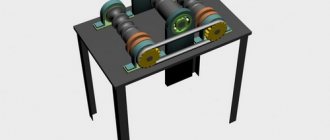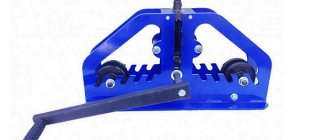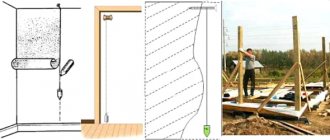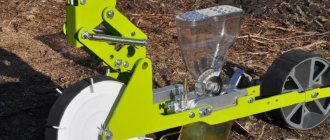You can bend a metal product in different ways, but without special tools the quality will be low. Using an edge bender you can solve many issues related to the preparation of parts from metal sheets.
Its features:
- possibility of bending to a specific length,
- no weld seams.
This makes it possible to prevent the formation of corrosion in the future and to produce elements of increased strength. The technique of working with the technical tool is simple. On its scale, it is enough to set the necessary bending parameters, insert a plane between the main and clamping parts and, moving, bend the edge.
This does not require significant effort or heating of the metal. Processing of products made of copper, aluminum, metal alloys and carbon steel is carried out by bending on machines or manually.
Device of manual edge benders
Edge bending machines are designed in such a way that the force acts simultaneously along the entire length of the edge or sheet blank. As a result, at the same time, the edge is deformed, but the metal does not warp, but lies in an even seam.
The designs of such equipment are divided into types:
- rotary,
- press,
- rotary.
The modern market provides the opportunity to purchase different designs of sheet bending devices, but you can make them yourself.
Edge bending tools are similar in appearance to sheet bending products, but the devices are structurally different from each other. The length of the flanging working area for manual edge benders can be small, because the parameters of the bead height and radius of curvature do not change.
If, with a large extent of edge formation, it is necessary to carry out the process simultaneously, the principle of operation of the edge bender is more similar to the sheet bending technology; the difference, in fact, is only in the method of pressing the workpiece.
DIY hydraulic sheet bender
A bending machine for sheet metal can be made at home.
Not every home craftsman needs such equipment, but for those, for example, who do roofing work, it will help to significantly increase their own earnings. And for some, perhaps, it will become the first machine of the future plant.
Areas of application
Metal bending devices are used in various industries. They are used to create folds from roofing iron, make rectangular air ducts from tin or metal sheets, prepare the edges of products for welding, and parts of geometric shapes. Manual edge benders are actively used for construction and repair work. They are in demand during car repairs.
Among the advantages of this technology, in addition to the small thickness of the resulting edges and the low cost of rolled metal, one should add high resistance to wear.
Where is edge bender used?
The device has found application in many areas of industry. In particular, it can be used to form seams in roofing iron, air ducts, and prepare product edges for welded joints. Today, car repair is given one of the first places in the use of the device, since cars are becoming the most popular among the population every year.
Main varieties
Edge bending equipment is available in the form of mobile and stationary models. The designs of the machines are massive and practically cannot be disassembled.
They are mounted directly at the place of use, and are moved only with the help of technical means.
Models can be:
- manual,
- pneumatic,
- hydraulic.
A special place in the product line belongs to segmented manual devices intended for the manufacture of cases, boxes, i.e. products “closed” on all sides.” Due to the different configurations, the segments can be installed arbitrarily. Such equipment allows you to obtain any bending length that does not exceed the working length of the machine.
Tool models differ from each other not only in power, efficiency and thickness of the materials processed, but also in the type of metal.
Portable models of edge benders with gradual shaping consist of:
- two rubberized handles, one can be movable, the other cannot,
- lever system for applying force,
- working jaws with a profile corresponding to the edge parameters
- adjustable travel stop in the form of a slotted screw equipped with a thread.
Roller-type hand-held products have the simplest design. The whole process is carried out by a handle, and the main task of deforming the metal is performed by rollers. The bending width is regulated by a special limiter installed on the tool guides.
In a roller edge bender, friction during sliding of the jaws replaces rolling friction during rotation of the rollers. In this case, the forming force is significantly reduced, but the design of the tool is less universal, because it is impossible to change the edge formation parameters due to one pair of rollers. In addition, edge benders with rollers do not make it possible to carry out beading of small radii inside the product.
A significant disadvantage of portable models of hand tools is their lack of accuracy. As the device moves along the line of the future edge, the error gradually increases, which can reach more than a millimeter. This is unacceptable for work such as auto body repair, so the quality of the edges depends on the experience of the specialist. Because of these technical characteristics, it is advisable to use a roller edge bender only for solving simple problems.
A machine with a hydraulic drive is more functional. Thanks to its high power, it copes well with workpieces made of metal sheets, even of considerable thickness.
Manual edge bender for do-it-yourself auto repair - Metals, equipment, instructions
Such a simple tool as an edge bender can be useful in many situations involving the need to process sheet metal products. There are many models of such a device on the modern market, but if you wish, you can make it yourself.
Edge benders can be used to form quite complex profile elements
Areas of application
An edge bending machine or a simple hand tool designed for bending edges is widely used in many areas.
The edge bender makes it possible, in particular, to produce air duct elements from thin sheet metal and to prepare the edges of workpieces for joining them by welding.
Auto repair (body work) is another area of application for such tools and equipment.
Bending the end of a drainpipe on an electromechanical edge bending machine
If we talk about the principle by which the edge bender operates, it is quite simple. To bend the edge of a thin-sheet product, the edge bender scale is set to the required processing width, then the edge of the workpiece is placed between the working rollers of the device and, moving the device, the bend is performed.
Main varieties
The simplest design of the edge bending devices on the market are manual roller type devices.
All manipulations with such edge benders are carried out using the handle with which they are equipped, and the main work of deforming the edge of the metal workpiece is performed by the rollers.
The width of the bend performed using such a device is regulated by means of a special limiter installed on the guides of the device.
Compact manual edge benders can be used directly on site
High mobility of the edge bender, which can be used even on high-rise objects, is ensured not only by its compact dimensions, but also by its low weight, about 2 kg.
Using a hand-held edge bending tool, you can bend the edge of a metal workpiece at an angle of up to 90°, while the thickness of the metal from which it is made cannot exceed 0.8 mm.
Using an edge bender, you can make bends of any length, and their width can be in the range of 0.5–20 cm. As can be seen from the technical characteristics of such a device, its capabilities are quite limited, so it is advisable to use it only for solving simple technological problems.
An edge bending machine equipped with a hydraulic drive is more productive and functional. The operator working on such equipment does not need to exert significant physical effort in order to bend the edge of a metal workpiece.
Due to the high power that this device is distinguished by, it can be used for processing sheet metal workpieces even of considerable thickness.
Edge bending machine ZSH-4.0 with hydraulic roller clamping
Depending on the dimensions, a hydraulic edge bending machine can be stationary or mobile. It is the hydraulic drive that is most often equipped with such equipment, which also has another name - “edge bending press”.
The edge bending machine can also be equipped with an electromechanical drive. Using this equipment, you can make folds of various types and even perform upsetting of the folded seam, if the equipment of the machine allows this to be done.
Making an edge or trimming it on a roller machine uses replaceable rollers, on which the shape of the bend depends
Edge benders equipped with a pneumatic drive are very popular. The working parts of such a machine, operating on the “rotary beam” principle, through the use of a pneumatic drive, make it possible to exert significant pressure on the workpiece being processed, the value of which can reach up to 6.2 bar.
When deciding to use serial equipment in this category or make a pneumatic machine with your own hands, you must keep in mind that for such a device to fully operate, it is necessary to provide an air flow of 113 l/min.
Option one. Long straight edge bending machine
In order to make such a device, you will need its drawings, which are easy to find on the Internet, as well as the following equipment and consumables:
- metal channels from which the base and clamps of the edge bender are made;
- thick-walled corner for making a crimping punch;
- metal sheet from which the edge bender brushes will be made;
- a metal bracket used as a handle for a device.
How to make a manual edge bender for auto repair
To save money, you can make a homemade edge bender for body repair. It will greatly facilitate the production of, for example, patches on the threshold or fender of a car.
In this case, the repair site will not protrude above the surface, which will reduce the time and costs of puttying and painting.
A roller model for bending sheet metal can be made from:
- pairs of bearings,
- bolt for an axle with a diameter equal to the inner diameter of the bearings,
- thick metal plate,
- handles from a grinder.
The process of making a roller model for bending sheet metal
- Cut two pieces of the same length from the bolt and place the bearings on them.
- Drill holes in the plate for welding.
- Install bearings into the plate with a distance of 1 mm from each other.
- Weld a nut for the handle from a grinder to the center of the plate on the side opposite to the bearings.
Grinding and roughening tools
To make wood perfectly smooth, you need a sanding tool. Small figures and wood parts are sanded manually with sandpaper and sandpaper, making monotonous mechanical movements. To smooth the edges and ends of products, rasps are used. These are special files for wood with a large notch.
For large areas, electric woodworking machines are used, these include:
- grinders with grinding attachments;
- belt sanders;
- eccentric (orbital);
- surface grinding (vibrating).
A belt tool is more suitable for rough sanding, removing thick layers of paint or leveling a surface. Finer grinding is carried out using eccentric and surface grinding units.
https://youtube.com/watch?v=eE7APGHLIGU
Tinsmith's Tool
Such an edge bender is necessary during auto repair for a smooth transition of the metal patch to the base. After straightening, both planes must be coaxial with each other.
On a thin sheet of iron, it is impossible to guarantee the reliability of the butt weld joint. The device allows you to prepare an edge profile for overlap welding. It greatly simplifies the process of repairing a car body if you need to bend the metal at an angle of 90 degrees, i.e. make an edge or flange. Edge bending devices for auto repair are characterized by a simple design and low price, so making them yourself is not always impractical. Sometimes it is better to buy equipment for which there is an additional use in the household.
Video instructions on how to use a tinsmith's edge bender
How to make a paper hole punch with your own hands
To make it easier to pierce the sheet, it is better to preheat the awl on a gas burner. You can also use a regular lighter.
In this case, it is important to carefully monitor how hot the soldering iron is; if you are careless, you can make a large hole and get burned. A hole punch is a mechanical device that is designed to quickly punch holes in paper. There are tools that can be used to work with denser materials
Manufacturers offer hole punchers that can make one or four holes at a time
There are tools that can be used to work with denser materials. Manufacturers offer hole punchers that can make one or four holes at a time
A hole punch is a mechanical device that is designed to quickly punch holes in paper. There are tools that can be used to work with denser materials. Manufacturers offer hole punchers that can make one or four holes at a time.
In some cases, you don’t have the right tool at hand and you should know what you can use to replace the hole punch.
To make neat holes in the paper or card through which the sheet will later be fixed, you can use an awl. Such tools can be of different diameters; you can experiment if you don’t have a hole punch at hand.
An awl can also be used to make holes in thin plastic. It is better to warm up the rod first, this will make the work much easier. During the process, do not forget about safety rules so as not to get injured.
Pneumatic edge bender
Particularly popular among craftsmen are edge benders with pneumatic drive, which work as a “rotary beam”. The pneumatic drive contributes to significant pressure (up to 6.2 bar) on the workpiece. But such equipment can be used when working with sheet metal no thicker than 1.2 mm. In this case, the edge width will be no more than 12 mm.
If you want to make a pneumatic machine with your own hands, you must take into account that its operation requires an air flow of at least 113 l/min.
Pneumatic punch
This is a universal tool model. On one side, the structure is equipped with a mechanism for punching holes, on the other, with jaws for forming an edge.
Thanks to this, you can simultaneously bend the edge and make holes in the metal for fasteners. That is why the tool is often called a pneumatic punch. Its working part is made of high-speed steel. The rubberized handles of the product are equipped with springs. They help reduce pressure on the palm, which facilitates the process of punching and processing.
Any model of hole punch-edge bender works much faster and more efficiently than its manual counterparts, which is why it is intensively used at service stations and car repair shops.
Types of edge benders
The principle of its operation is to move across the width of the sheet being processed, as a result of which the metal product is gradually bent along the designated seam. The maximum width of the processed workpiece is 0.8 mm.
The portable manual edge bender includes the following components:
- movable rubberized handles;
- lever system with which the pressing force is adjusted;
- working jaws proportional to the width of the edge;
- travel limiter, presented in the form of a carved screw.
The negative properties of the manual device include the low accuracy of the edge bending operations performed. When manually moving the tool, the part may move out of the desired position, which leads to the formation of an error. As a result of such a manufacturing flaw, the processed object may acquire an incorrect shape.
Roller devices are more limited in their action, since one pair of built-in rollers is not enough to carry out operations to form a thin flange of a small radius. In this case, it is possible to replace the rollers that adapt to the shape of the bend, but such labor-intensive intervention in the product is doubtful.
Hydraulic edge bending tools allow you to perform more technologically advanced and intensive operations. The high power potential of this device allows processing edges of significant thickness. Machines with electromechanical and pneumatic drives are also distinguished by high product processing performance.
Hydraulic edge bender
How does an edge bending machine work?
Structurally, a metal bending machine consists of several parts:
- supporting surface,
- working base,
- clamping element
- crimping punch,
- levers-handles.
Some models are equipped with a hole punch and a knife for trimming edges. In the standard design, the supporting plane measuring 1m x 1.5m is a table made of wood or metal with powerful legs. The horizontal fastening of the base is made from channel No. 8 or 6.5. Metal structures are connected by welding, and wooden structures are connected by bolts.
Clamp
To clamp the surface when bending the edges, the device is equipped with a pressure bar - an angle with a shelf of 0.05 m. It presses against the punch at a given angle. Holes for bolts are drilled on both sides of the clamping mechanism. Also for clamping, “lambs” with pins welded to the base are used. More complex clamping parts are equipped with springs.
Punch
To make a punch, a square section of pipe is often used. The design of a part involves its horizontal rotation around an axis. In this case, the upper edge in front of the base exactly coincides with the punch.
For this purpose, the ends are equipped with loops. The clamp is located exactly vertically so that there are no distortions when bending metal. The punch is adjacent to the edge of the base without gaps so that the fold line is accurate. When not in use, the top edge of the punch is located in the same plane as the table plane. If the design has deviations, the fixture will work, but with an increased bend radius, which leads to a rounded straight line.
Drive unit
A manual drive made from a pair of pipe sections is connected by welding to the front or side of the punch. It can be in the form of a bracket or a telescopic lever. The length of the lever is firmly fixed for specific positions using pins connecting through the holes in increments of 0.1 m. This handle helps to distribute the load evenly, adjusting the force on the surface depending on its thickness. For example, the telescopic shape of the lever during body work allows you to increase the effort by more than 2 times.
How to choose
The WUKO tool line includes several models of various manual sheet benders, suitable for different requirements. The principle of their operation is the same: the roller mechanism bends the edge when the tool is pulled along the sheet manually. The company's engineers in the design of the sheet bender have originally implemented the process of flanging a metal sheet: roller guides simultaneously serve as a tool handle and a metric scale, allowing you to set the required distance for bending. The video demonstrates how the tool works.
Wuko Mini Bender. The simplest model of a manual sheet bender, the Wuko Mini Bender, has one pair of rollers. Model 2022 allows you to bend from 5 to 20 mm. There are options with the possibility of obtaining a higher side: 2030 and 2050.
WUKO DUO BENDER. For higher productivity, models with two pairs of rollers are available. They also differ in the amount of bend - from 200 mm (model 3200) to 350 (model 3350). There is also a version of WUKO DUO Bender 3350 PLUS, equipped with an additional removable handle and a support bar. Models with two rows of rollers are designed to work on straight sections.
- WUKO Uni Bender. To work on curved sections, especially when constructing dome structures, it is advisable to use special manual roller benders. They have an additional support roller, which simplifies the movement of the tool along the radius.
- DISC-O-BENDER. This tool is designed for forming a recumbent seam when making horizontal seams, joining valleys, and other works.
The range of manual roller bending tools is designed for professional roofers and tinsmiths performing various tasks in the installation of seam roofing and other sheet metal products. Manual sheet benders are used as additional convenient tools for sheet bending and seam-forming machines, but if necessary, you can use a manual roller sheet bender to produce a small volume of paintings when installing the roof yourself. If you decide to use a manual roller bender to create paintings for the roof, do not forget that the formation of each bend occurs in several steps: the tool beads the edge gradually, in several passes, so the production of the entire required volume of paintings, even for a relatively small roof of a country house, will take quite a long time time.
Self-production
The design of the hand bender is simple and elegant. On the Internet you can find drawings that allow you, if you have access to lathes and milling machines and the ability to use them, to reproduce the tool yourself. However, it must be taken into account that the factory-made tool has a special coating of the rollers - the most loaded part.
A variety of products made from tin and sheet metal, obtained by bending, are popular and in demand both in professional construction and mechanical engineering, as well as for minor household repairs and household needs. A fully functional do-it-yourself sheet bender for sheets up to 1.2 mm thick from ferrous, galvanized or non-ferrous metal can be made in a home workshop or a small metalworking shop.
Self-production
Following the drawings, you can make your own manual edge bender for processing metal of small thickness during car repair.
It is enough for him:
- corner,
- metal beams,
- hinges with bolts,
- clamps,
- handles,
- table,
- welding machine.
Preparatory stage
- Make a base from an I-beam profile.
- Bolt the corner to the top of the beam.
- Weld three hinges under the corner.
- Provide tight metal clamping with two clamps.
To make it easier to turn the machine while bending a sheet of metal, attach handles on both sides. Using clamps, attach the machine to the table.
For processing, the product is placed between the profile and the corner. The gap for it is formed after unscrewing the corner. The metal sheet is aligned along the edge and bent by turning the device by the handles.
Long straight edge bending machine
Making your own manual edge bender for long straight edges should begin with studying the drawings, as well as selecting the equipment and necessary materials:
- pairs of channel sections for the base and punch,
- corners with straight edges.
- welding machine,
- steel sheet,
- steel axles - rods with a cross-section of 10 mm,
- brushes with steel bristles,
- handle brackets.
4 main details:
- base,
- clamp,
- punch,
- pen.
First, you need to chamfer the edge of the crimping punch and weld the axles to it. The axes of the bar itself must coincide with the edge of the angle. Samples are made at the ends of the working part of the clamp.
For assembly, the base with the punch is clamped in a vice. In this case, the walls of the first and second shelves must be in the same plane. The gap between the parts will be created by a cardboard spacer. After this, the elements are firmly fixed in a vice.
Brushes with metal bristles are placed on the punch axis. These components are attached to the base using a clamp - a frame with a movable clamp.
Then the brushes are welded to the channel, and holes are drilled in the base into which the clamping bolts are screwed. Screw nuts onto hardware studs. Then they are welded to the channel.
After unscrewing, the bolts are inserted into the clamping holes and the limiting nuts are screwed onto them.
The handle-bracket is welded to the corner. The final stage of assembling the structure is installation in a vice.
Tools and materials
A manual edge bender is an ideal assistant for those who like to tinker with sheet metal and tin . But to start making a homemade tool, you will need to study its design in more detail.
The manual machine has:
There are several options for materials and initial tools from which an edge bender could be made. For example, it is quite easy to remake it from pliers.
But it is also important that the machine not only creates edges with ease, but also allows this work to be done with good quality.
To create a manual machine according to one of the drawings you will need to have on hand:
- channel No. 5, used to create the base;
- channel No. 6.5, from which the clamp is made;
- thick-walled corner;
- crimp type punch No. 5;
- steel sheet 5 mm thick for making brushes;
- for the handle – a bracket with a diameter of 15 mm.
The following parts are required for the flange bender:
- clamp;
- limiter;
- spring-loaded clamp;
- support bracket;
- top clamp;
- punch;
- rotary axis for the handle.
Manual edge bender for flanging
Beading is a method of bending an edge on cylindrical or oval products. During operation, the material stretches. Its value depends on the properties and thickness of the material, the inclination of the flanging angle, and the parameters of the edge.
Flanging is performed on a machine or using a manual edge bender with your own hands. This processing technology is necessary in preparation for soldering, welding, and in the manufacture of any flange.
Efficient metal beam bending machine
To make this option, you need a workbench with a relatively smooth and even surface, the material is preferably metal, but wood will do. You will also need corners with shelf dimensions of 4-5 cm, thickness - no more than 5 mm.
The dimensions of these parts depend primarily on the amount of work you intend to perform. You can also take metal beams, which are useful only if the complexity and severity of the work is really high.
You will need: a door hinge in the size of two pieces, screws with a diameter of 1.5 cm to 2.5, springs. You definitely need a welding machine and a hammer drill.
To make a sheet bending machine from beams, follow these instructions:
- Two beams are placed together, and door hinges are cut into the ends. The edge should be cut at forty-five degrees. The third beam should be cut identically, keep in mind that the depth needs to be increased, because this part should be more movable, unlike the others.
- You must weld two parts to one of the beams on both sides. Their purpose is to allow the fixing bolt to be attached.
- Bolts need to be attached to the parts.
- Now you need to attach the third beam, and attach metal plates on top, in the center of which you need to make holes with a diameter larger than those of the bolts.
- Cut the springs so that it lifts the third beam by one centimeter maximum.
- Be sure to attach two scraps to the top of the screw, which will be used as handles.
- Now weld a handle made of any material you like onto the third beam. After this you can start working.
Thanks to this recipe, you will get a machine with which you can bend parts of truly impressive sizes and thickness. Such a machine will definitely come in handy when building something, because large beams in the store really cost a lot.
Do-it-yourself manual edge bending - saving the family budget
Many people are interested in how to make an edge bender themselves, and how difficult it is. Making a simple design will take several evenings and save several thousand rubles. Another argument may be the urgency of use.
For example, for auto repair, using a hand-made edge bender will save time and nerves. But such equipment may be inferior to factory products in terms of accuracy and manufacturability.
Video - how to make an edge bender yourself
How to choose the kinematic diagram of a bending machine
The most accessible machines for making with your own hands are machines in which sheet metal will bend as a result of turning a movable crosshead. The operating principle of such a machine is as follows.
The workpiece to be bent is installed on the guide plane of the lower table of the machine and fixed by a stop, which is fixed to the support frame of the device (it is advisable to provide for adjustment of the stop).
In the guides of the sheet bending frame, the upper traverse moves back and forth, which, when moving downwards, clamps the bent product with its ruler.
In front of the lower table there is a rotating beam that can rotate around its axis. The rotation can be done with a handle from a lever drive, but a version with a foot drive can be made. In the latter case, the operator’s hands remain free, which makes it easier to manipulate the workpiece when it is pressed against the ruler of the upper traverse. In addition, when operating a sheet bending machine using a foot, your hands get less tired.
The set of bending tools on the top and rotary beams may vary. The easiest way for this purpose is to order a set of punches and dies with the required bending radii and standard seats. You will have to send all the details with your order - ruler, clamp, etc. – which will require qualified milling work for their production.
The bevel of the top beam will determine the largest value of the bending angle by which the sheet metal can change its axis.
To make such a unit with your own hands, you will need the following materials:
- steel channel number 6 and above;
- a set of steel angles intended for making your own machine support frame;
- thick-sheet broadband steel from which the rotary, upper and lower beams will be made;
- assorted fasteners;
- rod for the manufacture of a manual lever drive for turning a beam.
To make work easier, you can also use a bench vice, guides from a decommissioned lathe, as well as massive hinges from steel entrance doors.
Using a similar principle, you can make a homemade sheet bender using wooden parts. True, it will only be able to bend aluminum and thin-sheet steel (up to 1 mm in thickness), but in many cases these capabilities are quite sufficient, and the labor intensity of building a sheet bending machine with your own hands will be noticeably reduced. In particular, there is no need for welding operations. It should be noted that the working parts of such a machine should be made only from hardwood (pine, spruce are not suitable).
Having decided on the operating principle of the sheet bender, you can look for suitable drawings. However, a person with an engineering education will be able to produce a set of drawings independently. The advantage of this option is that a number of working drawings can be quickly modified and processed to suit specific capabilities and source materials.
Drawings of the sheet bender must take into account the method of installation. For small units, for example, the bending machine can be mobile or even portable. Otherwise, you will have to use welding to make a stable base, otherwise excessive mobility of the machine will reduce the accuracy of work on it.
Once the machine is ready, it must be checked for functionality and accuracy. To do this, bend a test strip of thick cardboard of the required thickness. If the bending is performed correctly, then the height of the strip flanges will be the same, and there will be no traces left on its surface from the deforming tool.
If you find an error, please select a piece of text and press Ctrl+Enter.











